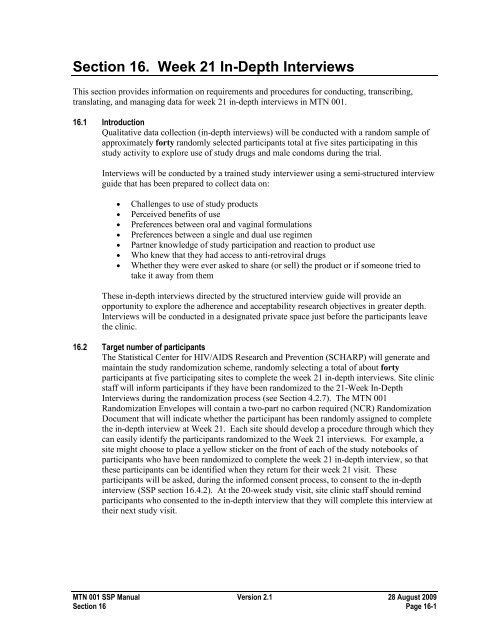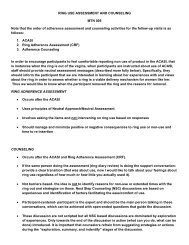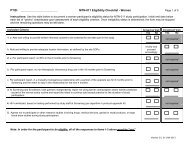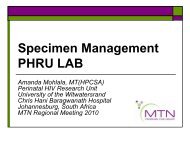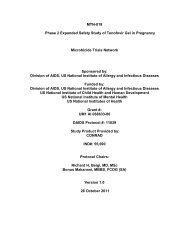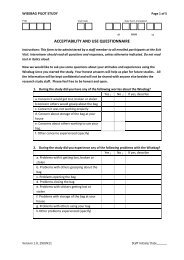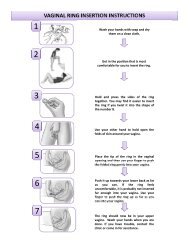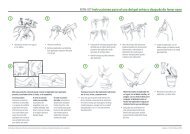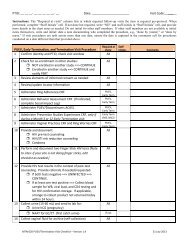Section 16. Week 21 In-Depth Interviews
Section 16. Week 21 In-Depth Interviews
Section 16. Week 21 In-Depth Interviews
You also want an ePaper? Increase the reach of your titles
YUMPU automatically turns print PDFs into web optimized ePapers that Google loves.
<strong>Section</strong> <strong>16.</strong> <strong>Week</strong> <strong>21</strong> <strong>In</strong>-<strong>Depth</strong> <strong>In</strong>terviews<br />
This section provides information on requirements and procedures for conducting, transcribing,<br />
translating, and managing data for week <strong>21</strong> in-depth interviews in MTN 001.<br />
<strong>16.</strong>1 <strong>In</strong>troduction<br />
Qualitative data collection (in-depth interviews) will be conducted with a random sample of<br />
approximately forty randomly selected participants total at five sites participating in this<br />
study activity to explore use of study drugs and male condoms during the trial.<br />
<strong>In</strong>terviews will be conducted by a trained study interviewer using a semi-structured interview<br />
guide that has been prepared to collect data on:<br />
• Challenges to use of study products<br />
• Perceived benefits of use<br />
• Preferences between oral and vaginal formulations<br />
• Preferences between a single and dual use regimen<br />
• Partner knowledge of study participation and reaction to product use<br />
• Who knew that they had access to anti-retroviral drugs<br />
• Whether they were ever asked to share (or sell) the product or if someone tried to<br />
take it away from them<br />
These in-depth interviews directed by the structured interview guide will provide an<br />
opportunity to explore the adherence and acceptability research objectives in greater depth.<br />
<strong>In</strong>terviews will be conducted in a designated private space just before the participants leave<br />
the clinic.<br />
<strong>16.</strong>2 Target number of participants<br />
The Statistical Center for HIV/AIDS Research and Prevention (SCHARP) will generate and<br />
maintain the study randomization scheme, randomly selecting a total of about forty<br />
participants at five participating sites to complete the week <strong>21</strong> in-depth interviews. Site clinic<br />
staff will inform participants if they have been randomized to the <strong>21</strong>-<strong>Week</strong> <strong>In</strong>-<strong>Depth</strong><br />
<strong>In</strong>terviews during the randomization process (see <strong>Section</strong> 4.2.7). The MTN 001<br />
Randomization Envelopes will contain a two-part no carbon required (NCR) Randomization<br />
Document that will indicate whether the participant has been randomly assigned to complete<br />
the in-depth interview at <strong>Week</strong> <strong>21</strong>. Each site should develop a procedure through which they<br />
can easily identify the participants randomized to the <strong>Week</strong> <strong>21</strong> interviews. For example, a<br />
site might choose to place a yellow sticker on the front of each of the study notebooks of<br />
participants who have been randomized to complete the week <strong>21</strong> in-depth interview, so that<br />
these participants can be identified when they return for their week <strong>21</strong> visit. These<br />
participants will be asked, during the informed consent process, to consent to the in-depth<br />
interview (SSP section <strong>16.</strong>4.2). At the 20-week study visit, site clinic staff should remind<br />
participants who consented to the in-depth interview that they will complete this interview at<br />
their next study visit.<br />
MTN 001 SSP Manual Version 2.1 28 August 2009<br />
<strong>Section</strong> 16 Page 16-1
Participants who are asked, but do not consent to the in-depth interview, will not complete the<br />
interview. <strong>In</strong> addition, participants who meet the criteria for replacement (SSP section<br />
4.2.7.1) will not participate in the in-depth interviews. If a participant is randomized to the indepth<br />
interview at enrollment, but subsequently meets the criteria for replacement, she will<br />
not complete the in-depth interview; rather, the participant enrolled to replace her will receive<br />
the same randomization assignments and will complete the in-depth interview in lieu of the<br />
original participant.<br />
<strong>16.</strong>3 Differential Adherence<br />
The purpose of the in-depth interviews is to collect qualitative data on participants who<br />
represent differing levels of adherence to study product (i.e., participants who report better<br />
adherence to study gel than study tablets, or vice-versa, or participants who report low or high<br />
adherence to both study gel and study tablets). <strong>In</strong> the event that the participants who are<br />
randomized to and complete the in-depth interviews do not represent differing levels of<br />
adherence, site staff, with input from the behavioral researchers, may select up to two<br />
additional study participants (who report differential study product adherence or who they<br />
believe would be good informants about product adherence) to complete the in-depth<br />
interview.<br />
<strong>16.</strong>3.1 Identification of participants reporting differential adherence and/or participants who may be<br />
good informants about product adherence<br />
SCHARP will periodically send the behavioral researchers at RTI a listing of the adherence<br />
data reported by the participants randomized to the in-depth interviews (as documented on the<br />
Case Report Forms). The behavioral researchers will review this listing and assess whether<br />
or not the data represent different levels of adherence to study products. <strong>In</strong> the event that the<br />
randomized participants at each participating site do not represent different levels of<br />
adherence to study products, the behavioral research team will work with the site to identify<br />
up to two additional participants to complete the week <strong>21</strong> in-depth interviews. These<br />
additional participants may be chosen based on differential reporting of adherence to study<br />
products (as documented on the Case Report Forms). They may also be chosen if they are<br />
identified by site staff as excellent informants (based on specific experiences they may have<br />
had using study product(s) or other comments they may have shared with site staff during<br />
study visits). If additional participants are needed for the in-depth interview, and if a site<br />
identifies a participant that may be a good candidate to participate in the interview (i.e., a<br />
participant that represents atypical adherence to study product, or a participant likely to be an<br />
excellent informant on study product experiences), the rationale will be communicated and<br />
discussed with the behavioral researchers. Participants whom study staff and behavioral<br />
researchers have identified as eligible and good candidates for the week-<strong>21</strong> in-depth<br />
interview may be asked by site staff at the 20-week study visit if they would be willing to<br />
complete the in-depth interview at their next study visit. Those participants who are asked<br />
and who have consented to the in-depth interviews will complete the interviews at their<br />
respective <strong>21</strong>-<strong>Week</strong> study visit.<br />
<strong>16.</strong>4 Data Collection<br />
During the <strong>21</strong>-<strong>Week</strong> in-depth interview process, the conversation will be recorded to ensure<br />
that all participant-provided information has been collected appropriately. <strong>In</strong> addition to<br />
recording of the interview, the interviewer will take notes on his/hers observations during the<br />
interview. Therefore, the interview data will consist of voice files, text files of the interview<br />
transcripts, and interviewer observational notes.<br />
MTN 001 SSP Manual Version 2.1 28 August 2009<br />
<strong>Section</strong> 16 Page 16-2
<strong>16.</strong>4.1 General Preparation Prior to <strong>In</strong>terview: Checklists<br />
<strong>In</strong> preparation for the interview, assemble and bring all necessary items to the interview<br />
room, including:<br />
• <strong>In</strong>terview guide<br />
• Digital tape recorder with a 128MB memory stick, a spare 8MB memory stick, and<br />
spare batteries<br />
• Notebook, pencils and/or pens<br />
• Clock or watch to time the interview<br />
• Register, re-imbursement log and vouchers/cash [site specific]<br />
To ensure the interview is successful, it is important to prepare prior to the study visit by:<br />
• Preparing the private and confidential room where the interview will be conducted,<br />
including arranging the furniture, placing a “Do Not Disturb” sign on the door, and<br />
ensuring that all materials are available.<br />
• Check the battery life meter on the digital recorder and make sure you have a full<br />
dark colored bar. For each interview, use new batteries just to be sure. Old batteries<br />
can be used for transcription.<br />
• Make sure that you are familiar with the way your digital recorder works. Test it and<br />
practice recording until you are confident about how to use it correctly (see section<br />
<strong>16.</strong>4.5).<br />
• Be aware of ambient noise, such as fans, street noise, etc. Place the recorder where it<br />
can record the participant’s voice clearly, while still being monitored by the<br />
facilitating team. You should test the sound quality in advance.<br />
• Be on time for the interview. It is very important to respect participants’ time.<br />
<strong>16.</strong>4.2 Reiterating <strong>In</strong>formed Consent<br />
As part of the enrollment informed consent process, participants will provide consent to<br />
participate in a recorded in-depth interview. Before the interview, it is important to review<br />
with the participant the information regarding the interviews that was provided to her during<br />
the enrollment process. Also, it is important to remind participants that every effort will be<br />
made to keep confidential all information that she provides in the interview. Please note that<br />
all participants assigned to complete the in-depth interview, whether through randomization<br />
or site selection, must sign an informed consent form before they participate in the in-depth<br />
interview.<br />
<strong>16.</strong>4.3 Style of <strong>In</strong>terviewing<br />
Below are some general tips to keep in mind when interviewing:<br />
• Build rapport. Start with an informal chat on a topic that will be of interest to the<br />
participant. For example, try to link the MTN-001 trial with issues/events in the<br />
community.<br />
• Motivate the participant to tell her story by showing sincere interest in what she is<br />
sharing through eye contact and probing. Silence can also be helpful (see section 13.5<br />
for interviewing techniques).<br />
MTN 001 SSP Manual Version 2.1 28 August 2009<br />
<strong>Section</strong> 16 Page 16-3
• Remain non-judgmental. Show understanding but do not show approval or<br />
disapproval, or share your own personal experiences. Show respect, acceptance and<br />
emotional support through empathetic tone of voice, gestures, responsive facial<br />
expression, nods, etc. Use expressions such as “I see” and “that’s interesting,” which<br />
show that the interviewer is paying attention without suggesting agreement or<br />
disagreement.<br />
• Do not interrupt the participant. Sometimes interviewers are so determined to get<br />
their point across that they interrupt and speak "over" the respondent. This is not only<br />
inappropriate behavior for the interviewer, but when individuals speak<br />
simultaneously the voice recording is unclear viand valuable information may be lost<br />
as a result.<br />
• A good interviewer listens attentively to every word and sentence, observes gestures,<br />
symbols, pauses, and emotions. Take record of all these.<br />
• There are no desirable or undesirable answers. Your manner should reflect great<br />
interest and compassion and this will encourage participants to share deeply their<br />
experiences.<br />
• “Difficult” questions should be asked when you sense that the conversation is relaxed<br />
and you have won the trust of the participant. The questions in the guides are<br />
arranged in a progressive order, from the general ones to the more specific.<br />
• Be especially sensitive to the effect the conversation may be having on the participant<br />
and how comfortable you are yourself in handling these questions, especially when<br />
discussing sexual issues.<br />
• “Difficult” questions can be asked repeatedly in different ways at different points<br />
during the interview.<br />
• Sometimes qualitative interviews can bring out strong emotions in a participant. The<br />
interviewer can change the topic, stop the interview to allow her to vent her emotions<br />
and/or shift to a neutral topic.<br />
• Sometimes participants give answers that they think we want to hear or that they<br />
think are expected by the trial, e.g. used condoms all the time. The interviewer can<br />
ask participants how easy it is to practice some public health messages or can make a<br />
note about her observations and why.<br />
• Be flexible yet focused; keep the dialogue focused. The participant may ask the<br />
question even before it is time to discuss it on the guide. The interviewer should<br />
judge for herself whether to go along and exhaust the question or to follow it up later.<br />
• The participant may also give another meaning to the question. The interviewer<br />
should be flexible enough to encourage new perspectives and experiences while at<br />
the same time maintaining focus in the discussion.<br />
• If the participant begins discussing something irrelevant, the interviewer should try to<br />
redirect the discussion to the appropriate topic.<br />
• Closing the discussion can be difficult once the participant is relaxed and trusting. Be<br />
sure to thank the participant for her willingness to share her experiences and once<br />
more assure her of confidentiality.<br />
• Sometimes the conversation may continue off record and important information<br />
related to the questions may be disclosed. Take note of this information and ask the<br />
participants if you may include these in your formal notes.<br />
MTN 001 SSP Manual Version 2.1 28 August 2009<br />
<strong>Section</strong> 16 Page 16-4
<strong>16.</strong>4.4 Digital recording and managing voice files<br />
This sub-section describes how to use the digital recorder and manage the voice files that it<br />
creates from the interview recordings. The 2 US sites will use a Sony ICD-SX68 Stick<br />
Recorder with transcription capacity (Note: US sites will receive individualized training to<br />
learn how to use the built in transcription software) and African sites will use a Sony ICD-<br />
SX68 without transcription capacity to record the interviews. The recorders come with a<br />
158MB Memory stick which holds about 185 hours of recording time. Please carefully<br />
review the ‘Operating <strong>In</strong>structions’ manual for the digital recorder to familiarize yourself<br />
with it. After review of the manual, site staff should install the IC recorder software CD on<br />
the computer where voice files will be transferred.<br />
Figure 16-1: Sony ICD- SX68DR9 Memory<br />
Stick Digital Voice Recorder<br />
<strong>16.</strong>4.5 Recording Preparation Prior to <strong>In</strong>terview<br />
Site counselors should practice using the recorder with colleagues to familiarize themselves<br />
with all aspects of recording, downloading, saving, labeling, transferring, and transcribing<br />
digital recordings. We cannot replace an interview that has been successfully carried out but<br />
the recording is lost, damaged, or inaudible.<br />
Make sure to set the clock for the recorder to the current date and time (see page 17-18 of<br />
Operating <strong>In</strong>structions manual). That way, the default label assigned to a voice file will<br />
include the actual interview date in “yyyy_mm_dd” format (i.e., 2005_03_26) when<br />
downloaded onto a computer after the interview, which will allow for the files to be arranged<br />
in chronological order, making it easy to locate files of interest.<br />
Make sure to set the recording level to “MANUAL”. Hold down the menu button and select<br />
the REC LEVEL menu option, use the forward and backwards buttons to select “MANUAL”<br />
(see pg 25-26 of the Operating <strong>In</strong>structions manual).<br />
MTN 001 SSP Manual Version 2.1 28 August 2009<br />
<strong>Section</strong> 16 Page 16-5
<strong>16.</strong>4.6 Recording the interview<br />
To start recording an interview press and hold the “REC/ PAUSE” button, speak into the<br />
microphone and adjust the recording volume as needed, press the “REC/PAUSE” button (the<br />
operation indicator lights in red and “REC” will be displayed). To pause a recording, press<br />
“REC/PAUSE”, to end a recording, press “STOP”. Each time you start to record an interview<br />
and then press the stop button, a separate voice file is made. To avoid having several voice<br />
files for the one interview, it is recommended that the “REC/PAUSE” button be used to pause<br />
and resume the interview, and press the “STOP” button when finishing the interview.<br />
The Sony ICD-SX68 Memory Stick Recorder is organized into five folders (FOLDER01 to<br />
FOLDER05). Each file created is assigned to these folders in a chronological order, or the<br />
user can specify a folder.<br />
<strong>16.</strong>4.7 Procedures Following the <strong>In</strong>terview<br />
As soon as you stop the recording, your digital voice recorder creates a sound file with a<br />
unique identity with date and time.<br />
Transfer of interview data from the recorder to a computer should happen immediately after<br />
the interview. Note: specific data transfer training will be provided to all sites<br />
• Connect the recorder to the computer using the USB connecting cable.<br />
• Start the Digital Voice Editor (which should have been installed in advance from the<br />
CD that comes with the recorder package).<br />
• The Voice Editor’s main window will pop up, showing the folders and file names for<br />
the Memory Stick recorder and the computer.<br />
• <strong>In</strong> the PC section (on the right), open the destination folder (“original downloads”),<br />
where the files are to be transferred.<br />
• <strong>In</strong> the Memory Stick section (on the left), open the folder of interest, select the files<br />
to be transferred, and drag and drop them into the destination folder on the PC side.<br />
• After the files have been transferred, they should appear in the destination folder.<br />
• Check the downloaded files. To listen to a voice file double-click on the file, and it<br />
will start to play. You can move the cursor on the playtime toolbar to listen to<br />
particular portions of the interview. You can take note of the time on the counter to<br />
listen to an interview section of interest later e.g. 1:20:06 to 1:35:45.<br />
• Create a new folder on your PC called “voice files-transcription.” Copy the files that<br />
you have saved successfully in the “original downloads” folder and save them in the<br />
“voice files-transcription” folder. This will be the copy of the recording that you will<br />
work with. Do not use the master file in “original downloads.”<br />
• All the voice files in the “voice files-transcription” folder should be relabeled from<br />
the default format to follow the following format: Study Staff ID, Clinic name,<br />
number of voice files per discussion/interview, date of interview (YYYYMMDD) -<br />
e.g. SSCase 1of1 20080723. SS is the staff ID of the note-taker. We hope the file<br />
naming format will help the site staff and other MTN-001 collaborators easily<br />
identify the files. Sites are free to add other pieces of information that maybe useful<br />
in the file name e.g. initials of note taker, etc.<br />
• Once the download is verified you can clear the memory stick of old files so that it<br />
will not get prematurely filled up during the next interview. Voice files can be<br />
selected, copied or deleted on the E: drive (for the voice recorder) using Windows<br />
File Manager.<br />
MTN 001 SSP Manual Version 2.1 28 August 2009<br />
<strong>Section</strong> 16 Page 16-6
When the voice files are first downloaded onto a computer, they have “*.msv” as the file<br />
extension. Create a folder named “original downloads.” This is your ‘Master tape’ of the<br />
interview. Do not change these files in any way (e.g., do not re-label). The voice files in this<br />
folder will serve as the original source of interview data and as a backup in case any of the<br />
data are lost or damaged in the future; for example, while it is being relabeled, transmitted, or<br />
analyzed. If the recorder’s date and time have been set correctly, as described above, the files<br />
should be automatically organized in chronological order.<br />
<strong>16.</strong>4.8 Backup, storage and transmission of voice files<br />
After the files have been set up in the computer, make two CDs of the voice-files. The first<br />
will be the original copy of the interview data in the “original downloads” folder and in the<br />
“voice files-transcription” folder, and stored in a locked file cabinet or drawer until all<br />
interviews are completed and all CDs can be securely mailed to the social science coordinator<br />
at RTI <strong>In</strong>ternational. The second copy will serve as a backup of the original downloads, and<br />
should be stored in a locked file cabinet or drawer in the “back up voice files-transcription”<br />
folder.<br />
<strong>16.</strong>5 Data Collation and Management<br />
For the <strong>In</strong>-<strong>Depth</strong> interviews data collection, data is defined as the electronic (digital recording<br />
and computer files) and manual (interviewers note, transcriptions) copies of all information<br />
collected during the interview. The final research output of these data will be written text in<br />
reports and paper publications.<br />
<strong>16.</strong>5.1 Transcriptions<br />
A transcript or transcription is a word-for-word written copy of a voice recorded interview.<br />
Transcribing a recording of interviews (in the language of the original interview) is necessary<br />
in order to consider and compare what participants say in their interviews. <strong>In</strong> a face-to-face<br />
interview the interviewer can observe non-verbal communication such as hand, face and body<br />
gestures. The original audio recording is the most accurate reproduction of the interview;<br />
however, one can only listen to the tone of speech but not the non-verbal gestures.<br />
Transcriptions accompanied by summaries and observational notes from of the interview<br />
provide an objective representation of the interview or discussion.<br />
A typed interview transcript serves as a written record of every word spoken by participants<br />
and it can be made accessible for analysis. A transcript provides the means to search for<br />
specific words and phrases mentioned in the interview using word processing or specialized<br />
qualitative data analysis software.<br />
Here are general instructions about transcribing interviews:<br />
• We recommend that you start to transcribe the interview recordings as soon as<br />
possible after the interview.<br />
• You may wish to first listen to parts of the recording or in its entirety once before you<br />
start transcribing to become familiar with the voices and content.<br />
• Write down unique identification particulars of the transcription at the top of the first<br />
page: time started; time finished; venue of interview; transcriber; translator; and<br />
date(s) of transcription and translation.<br />
MTN 001 SSP Manual Version 2.1 28 August 2009<br />
<strong>Section</strong> 16 Page 16-7
• Listen to the recording carefully, one phrase or portion at a time, and transcribe<br />
verbatim, including all words, in the language of interview. Abbreviations should be<br />
kept the way they were said, such as “I’d” and “we’ve.” Do not summarize thoughts<br />
or ideas. Do not change from the first person to the third person, i.e. if a participant<br />
said “I like it because” do not transcribe as “she likes it because…”<br />
• Sounds, crutch words or incomplete words such as Um,” “Er” or “Ahh…” after<br />
single words in a row do not need to be transcribed if it makes reading difficult,<br />
unless it is an important part of the narrator’s speech pattern.<br />
• <strong>In</strong>terviewers use feedback words and sounds such as “uh huh,” “yes” and<br />
“hmm” to engage with the interviewee, but they can make transcripts difficult to<br />
read. Use your judgment when to leave these out.<br />
• Do not revise the speaker’s words to force them into standard written prose. Leave<br />
untouched any sentence fragments, run-on sentences, and incorrect grammar.<br />
Commas and dashes may be used to reflect pauses in the spoken words.<br />
• Use the jargon, idioms and metaphors that participants used in the interview; this<br />
enriches the data.<br />
• <strong>In</strong>sert observations about non-verbal communication or the tone of voice of the<br />
speakers from the notes taken during interview or the transcription using [square<br />
brackets] to give it more depth and feeling e.g. [participant A standing and shouting];<br />
[participant laughing]; [I think participant A misunderstood the question].<br />
• Also include in [square brackets] explanations about why the interview was<br />
interrupted or why the recorder was turned off e.g., [<strong>In</strong>terview interrupted by a child<br />
crying].<br />
• Identify inaudible portions of the recording. If one word is inaudible, indicate the gap<br />
with a “_”. When multiple words are inaudible, insert “_+” or estimate the elapsed<br />
time using the indicator “.... # seconds”.<br />
• Place two question marks before and after a word or phrase where you are not sure<br />
e.g., “the partner always laughs” The interviewer needs to pay extra attention<br />
that there is minimal interference with the sound quality during the interview.<br />
• <strong>In</strong>dicate the end or break of a recording in capital letters, e.g., END 1of2; BEGIN<br />
2of2; END OF INTERVIEW.<br />
• The goal is to create a transcript that is both accurate and understandable to the<br />
reader. It need not include every utterance or describe every background noise, but it<br />
should reproduce as closely as possible the speaker's words. It should also be<br />
consistent in style and level of detail throughout.<br />
• After an interview voice recording is transcribed, it is critical that the transcriber and<br />
a second person (the interviewer, if different to the subscriber) read through it for<br />
accuracy. <strong>In</strong> particular, the interviewer should check that cultural words or<br />
vocabulary of the participants were transcribed properly and try to fill in anything<br />
that was found to be unclear during transcribing.<br />
<strong>16.</strong>5.2 Translations<br />
<strong>In</strong>terviews will be conducted in the language that participants are comfortable with. Each site<br />
is responsible for all translation activities, or for contracting out for translation services.<br />
After a non-English interview has been carried out, we recommend the following:<br />
• Transcribe verbatim the interview in the original language following the transcription<br />
guidelines above. Then, translate the transcript into English under the passage for<br />
each speaker.<br />
MTN 001 SSP Manual Version 2.1 28 August 2009<br />
<strong>Section</strong> 16 Page 16-8
• Where jargon, idioms and metaphors have been used by participants in the interview<br />
try to translate these as directly as possible in order to maintain their original<br />
meaning. For example, if participants talk about “small houses” translate this as<br />
“small houses” not as some other term. Explanations to outside readers can be written<br />
in brackets. Cultural terms that do not have easy translations may be written in the<br />
local language and explained through notes written in square brackets, i.e. ukusoma<br />
[thigh sex]<br />
• Team members can figure out what works best for them, whether the person who did<br />
transcription also translates the document or someone else.<br />
The transcriptions should include all observer notes and feedback notes from the participants.<br />
Please note that a certified translator must carry out all translations and that written<br />
certification of the translation must be obtained. A copy of the transcript, translated copy, and<br />
written certification of the translation must be sent to the RTI <strong>In</strong>ternational office in San<br />
Francisco (see <strong>Section</strong> <strong>16.</strong>4.8 for shipping address) no longer than four weeks after the last<br />
interview is completed.<br />
<strong>16.</strong>5.3 Data Management and Storage<br />
Correct handling, filing and storage of all paper and electronic files and CDs containing study<br />
data are important for organizational purposes, quality assurance, monitoring, and the<br />
protection of participant confidentiality. The interview data will be in the form of:<br />
• Enrollment data (with Participant ID number so that we can match their information<br />
with the trial data during the analysis).<br />
• Transcripts and translations accompanied by interview notes, filed by interview type.<br />
e.g. PTID_date of interview_ name of interviewer<br />
The main components of the data management system are:<br />
• To protect participant’s confidentiality, use PTIDs on interview data (forms, voice<br />
files and transcripts) so that the data are not directly linked to the participant’s name<br />
or other personal identifiers. Also, store interview materials separate from<br />
documents bearing participant’s identifiers such as informed consent form, and<br />
locator forms.<br />
• Storage of paper documents (in the participants file) and CD backups in locked file<br />
cabinets and electronic documents on password-protected, secure computers at the<br />
project offices for the study sites.<br />
• Access to the study data only by designated study staff.<br />
• Routine backup and transfer of data to RTI. Ensure that you backup your work on a<br />
daily basis.<br />
<strong>16.</strong>5.4 Electronic files<br />
All electronic study data, documents and voice recordings should be routinely backed up as<br />
follows:<br />
• Electronic study files should be automatically backed up each day on the office<br />
server.<br />
• Staff should make CD backups of interview recordings and other study documents at<br />
least once a week.<br />
MTN 001 SSP Manual Version 2.1 28 August 2009<br />
<strong>Section</strong> 16 Page 16-9
<strong>16.</strong>5.5 Data storage<br />
All study material will be completed, checked and filed at each research site. All qualitative<br />
back-up data will be kept at the sites throughout and after completion of the data collection.<br />
Per protocol sites are required to maintain all records for two years after the study. (see<br />
section 3 for data storage requirements following completion of the study). Records will be<br />
destroyed after the two year period. Records may not be destroyed without written permission<br />
from the MTN-001 protocol team chair.<br />
<strong>16.</strong>6 Data tracking<br />
This qualitative study falls under the administrative structure of the MTN-001 Trial. The<br />
sites responsibilities are outlined in the MTN-001 Protocol and MTN 001 SSP Manual.<br />
<strong>16.</strong>6.1 Site <strong>In</strong>vestigator responsibilities<br />
• Conduct the study in accordance with the relevant current protocol and recommend<br />
amendments where necessary.<br />
• Ensure that all study staff follow ethical procedures as approved by the IRB.<br />
• Maintain adequate and accurate records at the study site in accordance with this<br />
protocol and make those records available for inspection to study monitors and<br />
auditors.0.<br />
<strong>16.</strong>6.2 Data monitoring<br />
Data monitoring activities include:<br />
• After each interview, site staff will carefully review all interview data and participant<br />
files for any anomalies.<br />
• The interviewer will make a written report of any anomalies.<br />
• Transcriptions will be checked by a researcher other than the original transcriber<br />
before it is transmitted to the social science coordinator. During the analysis any<br />
passage of interest will also have the translation verified against the corresponding<br />
excerpt in the transcript of the original language of the interview.<br />
<strong>16.</strong>6.3 Sending Data<br />
When all materials (voice files, summary notes and transcripts) are completed (and no longer<br />
than 4 weeks after the completion of the last in-depth interview), each site should securely<br />
mail (with the ability to track progress or delivery confirmation) all materials to the<br />
Qualitative Data Coordinator at RTI <strong>In</strong>ternational:<br />
Alexandra Minnis<br />
Women’s Global Health Imperative<br />
RTI <strong>In</strong>ternational<br />
114 Sansome St, Suite 500<br />
San Francisco, CA, 94104 USA<br />
Phone: 415-848-1323<br />
Email: aminnis@rti.org<br />
Please package all materials carefully (for example, each CD should be protected by a case).<br />
Please also be sure to include a log of the all files/materials included in the package. (See<br />
Appendix 16-2 for check-list of materials to include).<br />
MTN 001 SSP Manual Version 2.1 28 August 2009<br />
<strong>Section</strong> 16 Page 16-10
<strong>Section</strong> Appendix 16-1<br />
<strong>In</strong>-depth <strong>In</strong>terview Questionnaire<br />
Hello, my name is [FACILITATOR]. I would like to congratulate you for completing the<br />
study, and today I would like to discuss your experiences with being in the Tenofovir study.<br />
I would like to hear your views and learn about any problems and difficulties as well the<br />
positive experiences you have had with the study products. Everything you say is important<br />
to our research and will help us to better understand women’s experiences using Tenofovir<br />
in the trial. Please feel free to speak openly and use any language or words you are most<br />
comfortable using. There are no right or wrong answers. Your name will not be written<br />
anywhere, which means that no one will know it was you who said something.<br />
Since this discussion is very important to us, I would like to record it, with your permission<br />
just to make sure that I do not miss any important things that we will discuss today, and I will<br />
also be taking notes while we talk (confirm their consent). The tapes and notes will be kept<br />
private and safe, your name will not be used and the documents will be destroyed when the<br />
trial is finished. The discussion will take a little over one half-hour. Do you have any<br />
questions before we start<br />
A: Study Experiences (3-5 minutes)<br />
1. What are some of the reasons that you joined the study<br />
[PROBE: getting tested for HIV; learn more about HIV prevention; compensation<br />
of the study; curiosity/experience; free medical exam; etc<br />
2. What are some of the reasons you stayed until the end<br />
[PROBE: What did you like about the study<br />
PROBE: What did you dislike about the study]<br />
B. Study product experience and use (10 minutes)<br />
3. Please tell me about your experience using the gel and applicator.<br />
[PROBE: What are the things you liked about the gel<br />
PROBE: What are the things you disliked about the gel<br />
PROBE: How did you feel about using the applicator]<br />
4. Please tell me about your experience taking the tablets<br />
[PROBE: What are the things you liked about the tablets<br />
PROBE: What are the things you disliked about the tablets]<br />
5. Please tell me about your experience using the gel together with the tablets.<br />
[PROBE: What are the things you liked about using the gel and tablets together<br />
MTN 001 SSP Manual Version 2.1 28 August 2009<br />
<strong>Section</strong> 16 Page 16-11
PROBE: What are the things you disliked about using the gel and tablets together]<br />
6. <strong>In</strong> some instances women prefer using the gel, in other instances women prefer taking the<br />
tablets, and in other instances women prefer using the gel and tablets together. Please tell<br />
me about instances when you preferred using the gel or preferred taking the tablets<br />
[PROBE: Tell me about the instances when you preferred using only the tablets.<br />
Why did you prefer using only the tablets, and not the gel<br />
PROBE: Tell me about the instances when you preferred using only the gel. Why did<br />
you prefer using only the gel, and not the tablets<br />
PROBE: Tell me about the instances when you preferred taking the tablets and gel<br />
together. Why did you prefer using the gel and tablets together]<br />
C. Product adherence (7-10 minutes)<br />
7. For some women it is not easy to use gel every day; yet for others it is easy. What was<br />
your experience<br />
[PROBE: Some women were not able to apply the gel everyday. What do you<br />
think could be some of the reasons that made it difficult for them to use the gel<br />
everyday What made it difficult for you to use the gel every day<br />
PROBE: Some women were able to use the gel everyday. What do you think<br />
could be some of the reasons that made it easy for them to use the gel everyday<br />
What made it easy for you to use the gel every day<br />
PROBE: Can you think of a time where you thought it would be very difficult to use<br />
the gel, but you were still able to use it If yes, can you tell me more about it<br />
PROBE: What do you think would make it easier for you to use gel every day<br />
PROBE: What were some of the things that did help you to use the gel<br />
PROBE: What were some of the things that helped you to remember to use the gel<br />
(Would a timer have helped, a friend, a partner)]<br />
8. For some women it is not easy to take the tablets every day; yet for others it is easy. What<br />
was your experience<br />
[PROBE: Some women were not able to take the tablets everyday. What do you<br />
think could be some of the reasons that made it difficult for them to take the<br />
tablets everyday What made it difficult for you to take the tablets every day<br />
MTN 001 SSP Manual Version 2.1 28 August 2009<br />
<strong>Section</strong> 16 Page 16-12
PROBE: Some women were able to take the tablets everyday. What do you think<br />
could be some of the reasons that made it easy for them to take the tablets everyday<br />
What made it easy for you to take the tablets every day<br />
PROBE: Can you think of a time where you thought it would be very difficult to<br />
take the tablets, but you were still able to use it If yes, can you tell me more<br />
about it<br />
PROBE: What do you think would make it easier for you to take the tablets every<br />
day<br />
PROBE: What were some of the things that did help you to take the tablets<br />
PROBE: What were some of the things that helped you to remember to take the<br />
tablets (Would a timer have helped, a friend, a partner)]<br />
D. Partners and relationship issues (5-7 minutes)<br />
9. Please describe what information you shared with your partner on your trial participation<br />
and gel/tablet use (when I say partner I mean your husband, or someone who you<br />
consider to be your primary male sexual partner)<br />
[PROBE: What did you tell your partner about your participation in the trial How<br />
did your partner react<br />
PROBE: How did your partner learn that you were using the gel the first time How<br />
did he react<br />
PROBE: How did your partner feel about you using the gel<br />
PROBE: How did your partner learn that you were taking the tablets How did he<br />
react]<br />
PROBE: How did your partner feel about you taking the tablets]<br />
10.Sometimes it is possible to use the gel and/or tablets without your partner noticing. What<br />
has been your experience<br />
[PROBE: Tell me about the times when you told your partner that you were using the<br />
gel. What are some of the reasons you told him How often did you tell him<br />
PROBE: Tell me about the times when you told your partner that you were taking<br />
the tablets. What are some of the reasons you told him How often did you tell him<br />
PROBE: Have you ever used the gel without your partner knowing What were the<br />
reasons that you did not tell him<br />
PROBE: Have you ever taken the tablets without your partner knowing What were<br />
MTN 001 SSP Manual Version 2.1 28 August 2009<br />
<strong>Section</strong> 16 Page 16-13
the reasons that you did not tell him]<br />
PROBE: What would happen if you tried to use the gel and/or tablets without your<br />
partner knowing How would your partner react if he found out you were taking the<br />
tablets and/or gel without him knowing]<br />
11.Do you think it is important for male partners to be involved in the decision to use the gel<br />
and/or tablets<br />
[PROBE: What are some of the reasons How can male partners be more engaged<br />
and empathetic about their partner’s use Do you think your partner could help you<br />
with using the product every day]<br />
E. Product Sharing (5-7 minutes)<br />
12.Who knew that you were taking tablets and gel provided by the study<br />
[PROBE: husband/primary partner, family members, neighbours, clients,<br />
community members<br />
PROBE: how did they find out<br />
PROBE: Did you want people to know or would you prefer that only you (or you and<br />
your partner) know]<br />
13.Sometimes family members or friends ask participants in the study to share some of their<br />
gel and/or tablets. Tell me about your experience sharing or someone taking away your<br />
study products.<br />
[PROBE: Tell me about the times that you shared your gel and/or tablets. What are<br />
some of the reasons that you shared your study gel and/or tablets<br />
PROBE: Tell me about the times that someone took your gel and/or tablets without<br />
your permission. How did it happen What are some of the reasons that the other<br />
person took your gel and/or tablets without your permission]<br />
G. Conclusion<br />
14.We do not yet know if the tablets or gel will prevent HIV infection. But thinking ahead<br />
to the future, if they are proven to prevent infection, would you use the gel or tablets<br />
A.E. reporting script: If the patient has mentioned anything at all that qualifies as an A.E.,<br />
you are required to ensure that she has reported it, and double check in her file. Here are<br />
some guidelines for what you might say<br />
MTN 001 SSP Manual Version 2.1 28 August 2009<br />
<strong>Section</strong> 16 Page 16-14
During our interview you mentioned ___ (specify A.E.). At the time did you tell clinic staff<br />
about (specify A.E.)<br />
If she says yes: Before you go, I am just going to double check that (specify A.E.) was<br />
recorded in your file.<br />
If she says no: For your health and safety, we need to make sure that this is recorded in<br />
your file. Before you go, we need to fill out a form to ensure that it has been recorded. Is<br />
that okay<br />
Ask if there are questions or comments on anything about the study or this discussion.<br />
Address any outstanding questions/comments that you may have postponed to the end of<br />
the discussion.<br />
Thank you for your time and information.<br />
MTN 001 SSP Manual Version 2.1 28 August 2009<br />
<strong>Section</strong> 16 Page 16-15
<strong>Section</strong> Appendix 16-2<br />
Checklist of Required Materials<br />
Name of <strong>In</strong>terviewer, Date of <strong>In</strong>terview, Location of <strong>In</strong>terview<br />
CD of electronic voice file (US sites only)<br />
English translation of interview transcript (international sites only)<br />
Certification of official translation (international sites only)<br />
Summary notes from interview (if any)<br />
MTN 001 SSP Manual Version 2.1 28 August 2009<br />
<strong>Section</strong> 16 Page 16-16


